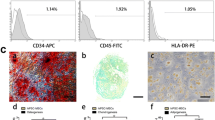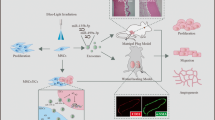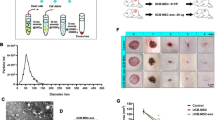Abstract
The underlying mechanisms of human umbilical cord mesenchymal stem cells (hucMSCs) and their exosomes (hucMSC-Exs), which play significant roles in skin wound healing, remain poorly understood. By using a rat model of deep second-degree burn injury, the roles of hucMSC-Exs in angiogenesis and cutaneous wound healing in vivo were investigated. We found that hucMSC-Exs accelerated skin wound healing and angiogenesis, inducing a higher wound-closure rate and increased expression of CD31 in vivo. We also discovered that hucMSC-Exs contained angiopoietin-2 (Ang-2), and treatment with hucMSC-Exs enhanced the expression of the Ang-2 protein in the wound area and human umbilical vein endothelial cells (HUVECs) through exosomal-mediated Ang-2 transfer. Moreover, hucMSC-Exs promoted the proliferative, migratory, and tube-forming ability of HUVECs. Furthermore, overexpression of Ang-2 in hucMSC-Exs further enhanced HUVEC migration and tube formation and exerted therapeutic and proangiogenic effects in cutaneous wounds in rats, whereas knockdown of Ang-2 in hucMSC-Exs abrogated these therapeutic and proangiogenic effects. Taken together, our results indicated that hucMSC-Ex-derived Ang-2 plays a significant role in tube formation of HUVECs and promotion of angiogenesis, and further suggested that hucMSC-Ex-based therapy may serve as a promising therapeutic approach for promoting cutaneous wound healing.







Similar content being viewed by others
Abbreviations
- hucMSC-Exs:
-
human umbilical cord mensenchymal stem cell-derived exosomes
- RT-qPCR:
-
quantitative reverse transcription polymerase chain reaction
- Ang-1:
-
angiopoietin-1
- Ang-2:
-
angiopoietin-2
- hucMSCs:
-
human umbilical cord mensenchymal stem cells
- HUVECs:
-
human umbilical vein endothelial cells
- MSCs:
-
mensenchymal stem cells
- MSC-Exs:
-
MSCs derived exosomes
- MEM:
-
minimum essential medium
- FBS:
-
fetal bovine serum
- DMEM:
-
dulbecco’s modified eagle medium
- PBS:
-
phosphatic buffer solution
- BCA:
-
bicinchoninic acid
- TEM:
-
transmission electron microscope
- NTA:
-
nanoparticle tracking analysis
- H&E:
-
hematoxylin and eosin
- BSA:
-
bovine serum albumin
- RIPA:
-
radio immunoprecipitation assay
- SDS-PAGE:
-
sodium dodecylsulphate polyacrylamide gel electrophoresis
- HRP:
-
horseradish peroxidase
- DAPI:
-
4′-6-Diamidino-2-phenylindole
- SD:
-
means ± standard deviation
- n.s.:
-
not significant
- TIE2:
-
tyrosine kinase with Ig and EGF homology domain 2
- VEGF:
-
vascular endothelial growth factor
References
Morikawa, S., Iribar, H., Gutierrez-Rivera, A., Ezaki, T., & Izeta, A. (2019). Pericytes in cutaneous wound healing. Advances in Experimental Medicine and Biology, 1147, 1–63.
Iqbal, T., Saaiq, M., & Ali, Z. (2013). Epidemiology and outcome of burns: early experience at the country’s first national burns centre. Burns : Journal of the International Society for Burn Injuries, 39(2), 358–362.
Batsali, A. K., Kastrinaki, M. C., Papadaki, H. A., & Pontikoglou, C. (2013). Mesenchymal stem cells derived from Wharton’s Jelly of the umbilical cord: biological properties and emerging clinical applications. Current Stem Cell Research & Therapy, 8(2), 144–155.
Kidoaki, S. (2019). Frustrated differentiation of mesenchymal stem cells. Biophysical Reviews, 11(3), 377–382.
Phinney, D. G., & Prockop, D. J. (2007). Concise review: mesenchymal stem/multipotent stromal cells: the state of transdifferentiation and modes of tissue repair–current views. Stem Cells, 25(11), 2896–2902.
Satija, N. K., Gurudutta, G. U., Sharma, S., Afrin, F., Gupta, P., Verma, Y. K., et al. (2007). Mesenchymal stem cells: molecular targets for tissue engineering. Stem Cells and Development , 16(1), 7–23.
Jo, Y. Y., Lee, H. J., Kook, S. Y., Choung, H. W., Park, J. Y., Chung, J. H., et al. (2007). Isolation and characterization of postnatal stem cells from human dental tissues. Tissue Engineering, 13(4), 767–773.
Battula, V. L., Treml, S., Abele, H., & Buhring, H. J. (2008). Prospective isolation and characterization of mesenchymal stem cells from human placenta using a frizzled-9-specific monoclonal antibody. Differentiation, 76(4), 326–336.
Miura, M., Gronthos, S., Zhao, M., Lu, B., Fisher, L. W., Robey, P. G., & Shi, S. (2003). SHED: stem cells from human exfoliated deciduous teeth. Proceedings of the National Academy of Sciences of the United States of America, 100(10), 5807–5812.
Arutyunyan, I., Elchaninov, A., Makarov, A., & Fatkhudinov, T. (2016). Umbilical cord as prospective source for mesenchymal stem cell-based therapy. Stem Cells International, 2016, 6901286.
Panepucci, R. A., Siufi, J. L., Silva, W. A., Jr., Proto-Siquiera, R., Neder, L., Orellana, M., et al. (2004). Comparison of gene expression of umbilical cord vein and bone marrow-derived mesenchymal stem cells. Stem Cells, 22(7), 1263–1278.
Chen, W., Liu, J., Manuchehrabadi, N., Weir, M. D., Zhu, Z., & Xu, H. H. (2013). Umbilical cord and bone marrow mesenchymal stem cell seeding on macroporous calcium phosphate for bone regeneration in rat cranial defects. Biomaterials, 34(38), 9917–9925.
Lazennec, G., & Jorgensen, C. (2008). Concise review: adult multipotent stromal cells and cancer: risk or benefit? Stem Cells, 26(6), 1387–1394.
Ljujic, B., Milovanovic, M., Volarevic, V., Murray, B., Bugarski, D., Przyborski, S., et al. (2013). Human mesenchymal stem cells creating an immunosuppressive environment and promote breast cancer in mice. Scientific Reports, 3, 2298.
Patel, S. A., Meyer, J. R., Greco, S. J., Corcoran, K. E., Bryan, M., & Rameshwar, P. (2010). Mesenchymal stem cells protect breast cancer cells through regulatory T cells: role of mesenchymal stem cell-derived TGF-beta. Journal of Immunology, 184(10), 5885–5894.
Wang, X., Zhang, Z., & Yao, C. (2010). Survivin is upregulated in myeloma cell lines cocultured with mesenchymal stem cells. Leukemia Research, 34(10), 1325–1329.
Xu, W., Qian, H., Zhu, W., Chen, Y., Shao, Q., Sun, X., et al. (2004). A novel tumor cell line cloned from mutated human embryonic bone marrow mesenchymal stem cells. Oncology Reports, 12(3), 501–508.
Volarevic, V., Markovic, B. S., Gazdic, M., Volarevic, A., Jovicic, N., Arsenijevic, N., et al. (2018). Ethical and safety issues of stem cell-based therapy. International Journal of Medical Sciences, 15(1), 36–45.
Bang, C., & Thum, T. (2012). Exosomes: new players in cell-cell communication. The International Journal of Biochemistry & Cell Biology, 44(11), 2060–2064.
Zhang, J., Chen, C., Hu, B., Niu, X., Liu, X., Zhang, G., et al. (2016). Exosomes derived from human endothelial progenitor cells accelerate cutaneous wound healing by promoting angiogenesis through Erk1/2 signaling. International Journal of Biological Sciences, 12(12), 1472–1487.
Zhang, J., Guan, J., Niu, X., Hu, G., Guo, S., Li, Q., et al. (2015). Exosomes released from human induced pluripotent stem cells-derived MSCs facilitate cutaneous wound healing by promoting collagen synthesis and angiogenesis. Journal of Translational Medicine, 13, 49.
Chen, C. Y., Rao, S. S., Ren, L., Hu, X. K., Tan, Y. J., Hu, Y., Luo, J., Liu, Y. W., Yin, H., Huang, J., Cao, J., Wang, Z. X., Liu, Z. Z., Liu, H. M., Tang, S. Y., Xu, R., & Xie, H. (2018). Exosomal DMBT1 from human urine-derived stem cells facilitates diabetic wound repair by promoting angiogenesis. Theranostics, 8(6), 1607–1623.
Gong, M., Yu, B., Wang, J., Wang, Y., Liu, M., Paul, C., Millard, R. W., Xiao, D. S., Ashraf, M., & Xu, M. (2017). Mesenchymal stem cells release exosomes that transfer miRNAs to endothelial cells and promote angiogenesis. Oncotarget, 8(28), 45200–45212.
Wang, X., Jiao, Y., Pan, Y., Zhang, L., Gong, H., Qi, Y., Wang, M., Gong, H., Shao, M., Wang, X., & Jiang, D. (2019). Fetal Dermal Mesenchymal Stem Cell-Derived Exosomes Accelerate Cutaneous Wound Healing by Activating Notch Signaling. Stem Cells International, 2019, 2402916.
Zhang, B., Wang, M., Gong, A., Zhang, X., Wu, X., Zhu, Y., et al. (2015). HucMSC-exosome mediated-wnt4 signaling is required for cutaneous wound healing. Stem Cells, 33(7), 2158–2168.
Yin, H., Chen, C. Y., Liu, Y. W., Tan, Y. J., Deng, Z. L., Yang, F., Huang, F. Y., Wen, C., Rao, S. S., Luo, M. J., Hu, X. K., Liu, Z. Z., Wang, Z. X., Cao, J., Liu, H. M., Liu, J. H., Yue, T., Tang, S. Y., & Xie, H. (2019). Synechococcus elongatus PCC7942 secretes extracellular vesicles to accelerate cutaneous wound healing by promoting angiogenesis. Theranostics, 9(9), 2678–2693.
Jian, R., Yang, M., & Xu, F. (2019). Lentiviral-mediated silencing of mast cell-expressed membrane protein 1 promotes angiogenesis of rats with cerebral ischemic stroke. Journal of Cellular Biochemistry, 120(10), 16786–16797.
Ding, J., Wang, X., Chen, B., Zhang, J., & Xu, J. (2019). Exosomes Derived from Human Bone Marrow Mesenchymal Stem Cells Stimulated by Deferoxamine Accelerate Cutaneous Wound Healing by Promoting Angiogenesis. BioMed Research International, 2019, 9742765.
Kant, V., Gopal, A., Kumar, D., Pathak, N. N., Ram, M., Jangir, B. L., et al. (2015). Curcumin-induced angiogenesis hastens wound healing in diabetic rats. Journal of Surgical Research, 193(2), 978–988.
Kong, Z., Hong, Y., Zhu, J., Cheng, X., & Liu, Y. (2018). Endothelial progenitor cells improve functional recovery in focal cerebral ischemia of rat by promoting angiogenesis via VEGF. Journal of Clinical Neuroscience, 55, 116–121.
Sun, T., Yin, L., & Kuang, H. (2019). miR-181a/b-5p regulates human umbilical vein endothelial cell angiogenesis by targeting PDGFRA. Cell Biochemistry & Function.
Zhou, Y., Yang, Y., Liang, T., Hu, Y., Tang, H., Song, D., & Fang, H. (2019). The regulatory effect of microRNA-21a-3p on the promotion of telocyte angiogenesis mediated by PI3K (p110alpha)/AKT/mTOR in LPS induced mice ARDS. Journal of Translational Medicine, 17(1), 427.
Li, L., Yu, Z. H., Qian, L., Xu, J. Y., Liu, F., Zhao, G. C., et al. (2016). Interleukin-19 and angiopoietin-2 can enhance angiogenesis of diabetic complications. Journal of Diabetic Complications, 30(2), 386–387.
Zhang, B., Wu, X., Zhang, X., Sun, Y., Yan, Y., Shi, H., et al. (2015). Human umbilical cord mesenchymal stem cell exosomes enhance angiogenesis through the Wnt4/beta-catenin pathway. Stem Cells Translational Medicine, 4(5), 513–522.
Song, Y., Dou, H., Li, X., Zhao, X., Li, Y., Liu, D., et al. (2017). Exosomal miR-146a contributes to the enhanced therapeutic efficacy of interleukin-1beta-primed mesenchymal stem cells against sepsis. Stem Cells, 35(5), 1208–1221.
Shi, H., Xu, X., Zhang, B., Xu, J., Pan, Z., Gong, A., Zhang, X., Li, R., Sun, Y., Yan, Y., Mao, F., Qian, H., & Xu, W. (2017). 3,3’-Diindolylmethane stimulates exosomal Wnt11 autocrine signaling in human umbilical cord mesenchymal stem cells to enhance wound healing. Theranostics, 7(6), 1674–1688.
Zhang, B., Shi, Y., Gong, A., Pan, Z., Shi, H., Yang, H., et al. (2016). HucMSC exosome-delivered 14-3-3zeta orchestrates self-control of the Wnt response via modulation of YAP during cutaneous regeneration. Stem Cells, 34(10), 2485–2500.
Saharinen, P., & Alitalo, K. (2011). The yin, the yang, and the angiopoietin-1. Journal of Clinical Investigation, 121(6), 2157–2159.
Yan, Y., Xu, W., Qian, H., Si, Y., Zhu, W., Cao, H., et al. (2009). Mesenchymal stem cells from human umbilical cords ameliorate mouse hepatic injury in vivo. Liver International, 29(3), 356–365.
Baudin, B., Bruneel, A., Bosselut, N., & Vaubourdolle, M. (2007). A protocol for isolation and culture of human umbilical vein endothelial cells. Nature Protocols, 2(3), 481–485.
Zhu, W., Huang, L., Li, Y., Zhang, X., Gu, J., Yan, Y., et al. (2012). Exosomes derived from human bone marrow mesenchymal stem cells promote tumor growth in vivo. Cancer Letters, 315(1), 28–37.
Nacer Khodja, A., Mahlous, M., Tahtat, D., Benamer, S., Larbi Youcef, S., Chader, H., et al. (2013). Evaluation of healing activity of PVA/chitosan hydrogels on deep second degree burn: pharmacological and toxicological tests. Burns : Journal of the International Society for Burn Injuries, 39(1), 98–104.
Eklund, L., & Olsen, B. R. (2006). Tie receptors and their angiopoietin ligands are context-dependent regulators of vascular remodeling. Experimental Cell Research, 312(5), 630–641.
Li, K. C., Wang, C. H., Zou, J. J., Qu, C., Wang, X. L., Tian, X. S., et al. (2020). Loss of Atg7 in endothelial cells enhanced cutaneous wound healing in a mouse model. Journal of Surgical Research, 249, 145–155.
Yang, C., Luo, L., Bai, X., Shen, K., Liu, K., Wang, J., & Hu, D. (2020). Highly-expressed micoRNA-21 in adipose derived stem cell exosomes can enhance the migration and proliferation of the HaCaT cells by increasing the MMP-9 expression through the PI3K/AKT pathway. Archives of Biochemistry and Biophysics, 681, 108259.
Thangavel, P., Pathak, P., Kuttalam, I., & Lonchin, S. (2019). Effect of ethanolic extract of Melia dubia leaves on full-thickness cutaneous wounds in Wistar rats. Dermatologic Therapy, 32(6), e13077.
Zhang, S., Chen, L., Zhang, G., & Zhang, B. (2020). Umbilical cord-matrix stem cells induce the functional restoration of vascular endothelial cells and enhance skin wound healing in diabetic mice via the polarized macrophages. Stem Cell Research & Therapy, 11(1), 39.
Hu, Y., Rao, S. S., Wang, Z. X., Cao, J., Tan, Y. J., Luo, J., Li, H. M., Zhang, W. S., Chen, C. Y., & Xie, H. (2018). Exosomes from human umbilical cord blood accelerate cutaneous wound healing through miR-21-3p-mediated promotion of angiogenesis and fibroblast function. Theranostics, 8(1), 169–184.
Duan, B., Shi, S., Yue, H., You, B., Shan, Y., Zhu, Z., et al. (2019). Exosomal miR-17-5p promotes angiogenesis in nasopharyngeal carcinoma via targeting BAMBI. Journal of Cancer, 10(26), 6681–6692.
Umezu, T., Tadokoro, H., Azuma, K., Yoshizawa, S., Ohyashiki, K., & Ohyashiki, J. H. (2014). Exosomal miR-135b shed from hypoxic multiple myeloma cells enhances angiogenesis by targeting factor-inhibiting HIF-1. Blood, 124(25), 3748–3757.
Shang, D., Xie, C., Hu, J., Tan, J., Yuan, Y., Liu, Z., & Yang, Z. (2020). Pancreatic cancer cell-derived exosomal microRNA-27a promotes angiogenesis of human microvascular endothelial cells in pancreatic cancer via BTG2. Journal of Cellular and Molecular Medicine, 24(1), 588–604.
Lyle, C. L., Belghasem, M., & Chitalia, V. C. (2019). c-Cbl: An Important Regulator and a Target in Angiogenesis and Tumorigenesis. Cells, 8(5).
Akwii, R. G., Sajib, M. S., Zahra, F. T., & Mikelis, C. M. (2019). Role of Angiopoietin-2 in Vascular Physiology and Pathophysiology. Cells, 8(5).
Suri, C., Jones, P. F., Patan, S., Bartunkova, S., Maisonpierre, P. C., Davis, S., Sato, T. N., & Yancopoulos, G. D. (1996). Requisite role of angiopoietin-1, a ligand for the TIE2 receptor, during embryonic angiogenesis. Cell, 87(7), 1171–1180.
Maisonpierre, P. C., Suri, C., Jones, P. F., Bartunkova, S., Wiegand, S. J., Radziejewski, C., Compton, D., McClain, J., Aldrich, T. H., Papadopoulos, N., Daly, T. J., Davis, S., Sato, T. N., & Yancopoulos, G. D. (1997). Angiopoietin-2, a natural antagonist for Tie2 that disrupts in vivo angiogenesis. Science, 277(5322), 55–60.
Author information
Authors and Affiliations
Contributions
Material preparation, data collection and analysis were performed by Jinwen Liu, Zhixin Yan, Fuji Yang and Yan Huang. Jinwen Liu wrote the first draft of the manuscript and all authors read and approved the final manuscript. Dawei Cui contributed to analysis of data, paper writing and first revision. Yongmin Yan contributed to do experiment design, and also contributed in the manuscript preparation.
Corresponding author
Additional information
Publisher's Note
Springer Nature remains neutral with regard to jurisdictional claims in published maps and institutional affiliations.
This article belongs to the Topical Collection: Special Issue on Exosomes and Microvesicles: from Stem Cell Biology to Translation in Human Diseases
Guest Editor: Giovanni Camussi
Rights and permissions
About this article
Cite this article
Liu, J., Yan, Z., Yang, F. et al. Exosomes Derived from Human Umbilical Cord Mesenchymal Stem Cells Accelerate Cutaneous Wound Healing by Enhancing Angiogenesis through Delivering Angiopoietin-2. Stem Cell Rev and Rep 17, 305–317 (2021). https://doi.org/10.1007/s12015-020-09992-7
Published:
Issue Date:
DOI: https://doi.org/10.1007/s12015-020-09992-7




